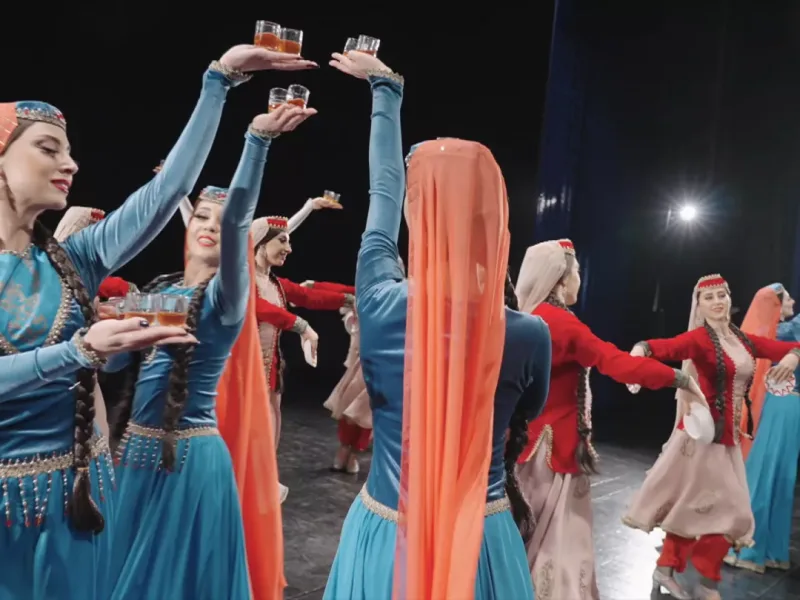One of the most colorful and dynamic reflections of Turkish culture is undoubtedly traditional folk dances. These dances are not merely aesthetic performances; they are cultural heritage elements that reflect the lifestyle, history, nature, and social structure of each region. This rich dance tradition, collected from all corners of Anatolia, is passed down from generation to generation, contributing to the preservation of national identity. Here are the most well-known folk dances specific to different regions of Turkey:
Zeybek
Zeybek, the most famous dance of Western Anatolia, is especially popular in Aydın, Denizli, Muğla, Manisa, and İzmir, and is also performed in cities like Afyon, Antalya, Isparta, Burdur, and Sakarya. Zeybek is known for its slow, sometimes vigorous movements. The dance can be performed solo or in a circle, and its varieties include Ağır Zeybek, Köroğlu Zeybeği, and Sepetçioğlu Zeybeği, usually performed by women. The dancers’ posture and the firmness of the movements reflect the region’s historical heroism and struggles of life.
Spoon Dance (Kaşık Oyunu)
One of the most common traditional dances in Konya and its surroundings, the Spoon Dance is performed with wooden spoons held in the dancers’ hands as rhythm instruments. It has many variations, such as “Aslan Mustafa, Sektirme, Keklik, Yerli Oyun, Sallama, Genç Osman, Emmiler, Galkınma, İnce Çayır, Menberi, Turnalar.” Originating from Central Asia, this dance is performed in circles or facing each other, emphasizing body coordination, rhythm, and aesthetics.
Hora
Hora is a folk dance performed in the Thrace region, especially in Kırklareli, Tekirdağ, and Edirne. Dancers hold hands or link arms and move rhythmically side by side. Performed by both men and women together, this dance is noted for its fast tempo and coordinated footwork. Turkish communities in the Balkans also frequently perform Hora at weddings and celebrations.
Çiftetelli
Çiftetelli evolved from Ottoman palace entertainment into a folk dance and is performed to stringed and wind instruments. It is characterized by chest and belly movements, neck twists, rich figures, and freedom of movement. Çiftetelli can be performed solo or in groups and is widespread throughout Anatolia today.
Horon
Horon, a symbol of the Black Sea region, is performed in Rize, Artvin, Ordu, Sinop, Samsun, Trabzon, Giresun, and Gümüşhane. This fast, lively, and dynamic dance reflects the region’s rugged terrain, mountainous landscape, and maritime lifestyle. Hemşin horon is accompanied by the tulum, while Rize horon is accompanied by the kemençe. Shaking, trembling, and quivering movements in horon represent the vitality of fish emerging from the sea. The person leading the horon is called the “horoncu başı.”
Greeting (Karşılama)
Karşılama, performed by two people or in groups, is common in Thrace and the Marmara region. Dancers line up facing each other, sometimes holding handkerchiefs. Variants specific to Giresun and Trabzon also exist. Basic movements include walking, stomping, and squatting for men. Performed to davul-zurna, bağlama, and kemençe, the dance emphasizes rhythm and aesthetic harmony.
Bar
Bar, a communal dance of Eastern Anatolia, is widespread from Bayburt to Kars, Erzurum, and surrounding provinces. Dancers hold hands and perform in a straight line or semi-circle. Bar reflects regional culture through disciplined steps, coordinated group movements, and the instruments used (violin, oud, clarinet, def). Each step and rhythm symbolizes solidarity and community spirit.
Conclusion
Traditional Turkish folk dances are more than mere entertainment; they are living heritage that has carried history, culture, and social values across centuries. Each dance vividly reflects the natural, social, and cultural fabric of its region. Traveling across Anatolia and witnessing these dances is one of the most enjoyable ways to explore Turkey’s cultural richness.

